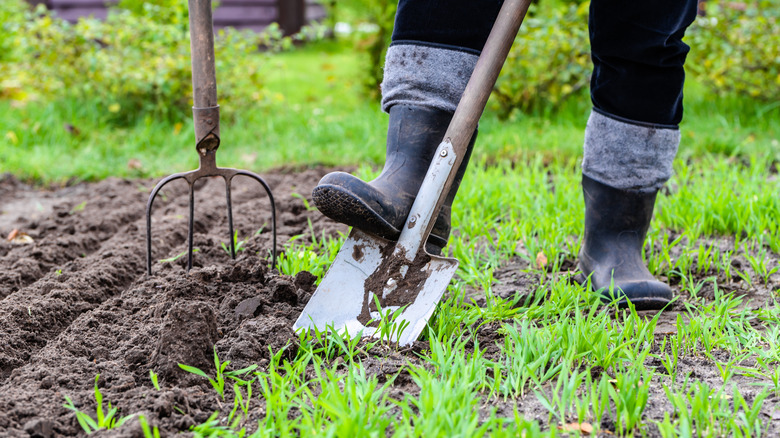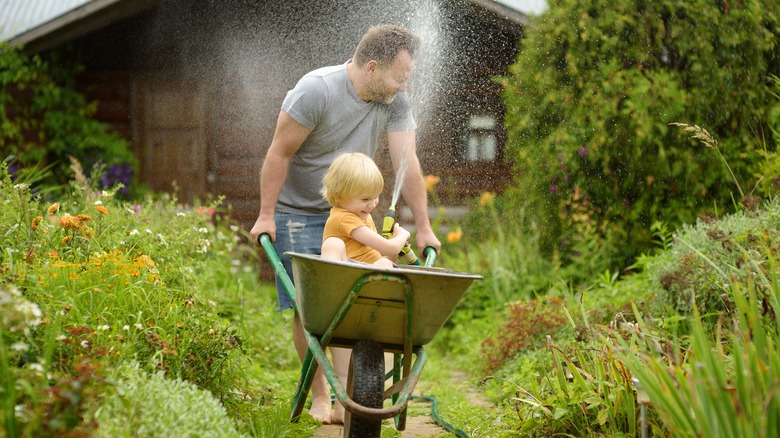How To Grow Your Own Victory Garden
We may receive a commission on purchases made from links.
When healthy young men were sent overseas during World War I and World War II, Americans were encouraged to learn to grow their own food. The effort began with the creation of the National War Garden Commission. The goal of this group was to encourage people to grow and store their own food so that shelf-stable products could be shipped overseas to help feed our troops and allies. (via History) Pamphlets and instructional manuals were widely distributed to teach people to grow the most popular and easy-to-preserve crops like tomatoes and squash. Victory Gardens were not only a practical way to encourage people to grow their own food, but they also provided an opportunity to boost national morale — everyone could support the war effort by simply growing a garden. First Lady Eleanor Roosevelt even did her patriotic duty by turning part of the White House lawn into a victory garden.
Although we no longer need to grow food to show our patriotism during wartime, the last few years have taught us that supply chain issues can happen quickly, and inflation can take a big bite out of our budgets. Growing a victory garden today not only lessens the burden of grocery costs but also offers an opportunity to get outside, release some stress, and learn something new.
Supplies
Victory gardens are all about saving money and making do, so as you acquire supplies, focus on what you need and don't get drawn in by expensive specialty garden tools that only do one job. Garden Design has a few suggestions for supplies everyone needs for gardening. Invest in the best pair of gardening gloves you can afford. Look for something that fits — well ––like a glove! Sure, you can get gloves at the dollar store, but one good pair of gloves can last several years and offer the right fit and protection you need to keep your hands safe as you work.
You really do not need a lot of garden tools. If you are growing in raised beds or loose soil, a spading fork is an efficient way to loosen soil without a tiller. You will also need a hand trowel for planting, pruning shears to remove excess or damaged limbs, and a shovel if you are planning on planting large bushes or trees. For weeding and loosening soil in small areas, a hand cultivator is useful.
Location
"Location, location, location" is not just a saying appropriate for buying real estate — choosing the right location for your victory garden can be the difference between a successful harvest and a season of frustration. When victory gardens were first introduced, people typically planted in-ground gardens in their yards or even in public spaces like public parks. When selecting a location, keep in mind that soil can be amended based on soil tests, but you cannot adjust the sun. The NJAES states the best location for your garden is in an area that gets at least 8 hours of sunlight. While some veggies will grow in partial shade, most fruit-bearing plants like peppers, cucumbers, and squash require full sun to thrive and produce.
Although raised gardens were not common when victory gardens were first introduced, they are an option now if you have rocky soil or other issues. Raised gardens do come with the initial investment of materials and store-bought soil with amendments. If you must make a raised bed, you can save money by building your own simple garden beds and buying soil in bulk.
Preparation
Now that you have your tools and garden location decided, it's time to prepare to plant. For in-ground gardens, the fastest way to prep your garden is to till the soil and remove all grass and weeds. Tillers are expensive, but many places rent them by the day, which can save you a lot of money on the initial purchase, maintenance, and storage.
The minerals and nutrients in soils vary greatly, so get a soil test as soon as possible to see if you need to make any amendments. The OSU Extension Service recommends adding a few inches of compost to the soil surface and tilling it or working it into the soil with a shovel or spading fork. This helps improve soil structure and add beneficial nutrients. Some cities even have programs that offer free or inexpensive compost for residents. If you are growing in raised beds, use a spading fork to loosen the soil and remove unwanted plants.
What to grow
When the concept of victory gardens was first developed, the National War Garden Commission published specific plans for the ideal garden size and layout for the typical four-person family. This plan was created for efficiency and max production. They even provided seed packs with their pamphlet distribution to make sure gardeners had everything they needed to get started. Our modern gardens do not have to be quite as structured.
Growing a Good Life states there is no point in growing food your family will not eat. If you don't like peas, it's probably best to plant something else. (Although, if you have never had fresh peas straight from the garden, it's worth giving them a shot!) Most people grow tomatoes, but if you do not like them, choose something else. Seed catalogs are filled with amazing plant varieties, so spend some time thinking about what produce you buy and eat the most and focus on learning to grow those crops.
Maintenance
Gardens require some maintenance throughout the growing season. Of course, the most fun part of gardening is the harvest, but in order to keep your plants healthy, spend a bit of time taking care of them. Weeding is probably the most dreaded task for most gardeners, but keeping your garden mulched is an efficient way to significantly cut down on weeds. Mulching also helps your soil retain moisture, reducing the frequency of watering, which saves money, according to Fra-Dor. Shredded leaves, grass clippings, and pine needles are all free or inexpensive mulch options.
Growing plants require a lot of nutrients to stay healthy and keep producing. Pro-Mix recommends applying a granular fertilizer to each plant about once a month to ensure your garden has everything it needs to continue to thrive throughout the growing season. You will also almost certainly need to water your garden, especially during the hot summer months. A drip irrigation system is an efficient way to give your plants the water they need, but these systems can be expensive. If you are on a budget, an overhead sprinkler or handheld sprayer also gets the job done. With good preparation and maintenance, you will get to enjoy your harvests throughout the growing season, and that in itself is a victory that deserves to be celebrated.





